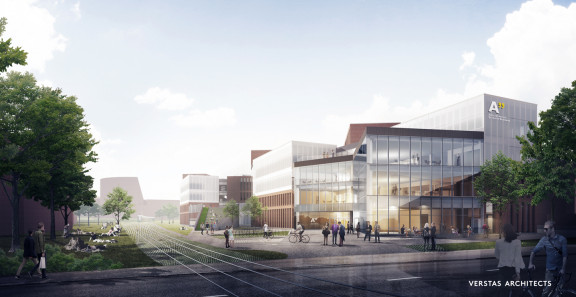Sitowise is responsible for the structural, HPAC and automation design of this structurally diverse and exceptionally energy-efficient property.
During the past few years, Otaniemi campus of Aalto University has undergone quite a change in appearance. The old red-brick buildings have been extensively renovated, and new constructions that are architecturally impressive yet blend in well with the old building stock have attracted architecture enthusiasts to the area from far and wide.
An exceptionally visually stunning building complex has sprung up right at the heart of the campus as part of the main Otaniemi campus of Aalto University. It is designed by Verstas Arkkitehdit Oy, winner of the architectural competition. The project has been carried out jointly by SRV Construction and Aalto University Properties. By summer, the four-storey building will house multipurpose teaching and office facilities for the Aalto University School of Arts, Design and Architecture. Construction work began in February 2016, and the University facilities will be completed in late April.
By the end of June, specialty department stores, restaurants and cafés will be completed for the Metro shopping centre on the building’s ground floor. The total floor area of the property is around 34,000 square metres.
A new building for the Aalto University School of Business will be completed in late 2018 at Maarintie 13.
The extent of the construction project is illustrated by the fact that it is the largest of its kind in Otaniemi since the construction of the University of Technology designed by Alvar Aalto. Its total value is EUR 101 million.
An ambitious energy solution
Designs for the HPAC and automation systems, ground source heat system and energy and cooling technology of the Väre building were the work of five experts of Sitowise’s Department of Technical Building Services. “We also carried out simulations of the building’s conditions,” says Design Manager Johannes Helander.
From the perspective of technical building services design, the project is particularly interesting due to its ambitious approach to energy efficiency.
Aalto University campuses seek to improve energy efficiency in the long term by reducing energy consumption and investing in local energy production. Otaniemi plans to achieve energy self-sufficiency by 2030.
The potential for energy savings of existing buildings has been carefully examined, and their energy-efficiency will be improved in connection with future renovations. The goal is by utilising geothermal and solar energy to achieve the ambitious A energy efficiency class for the facilities.
This is also the case for Väre. Renewable geothermal energy produces 90% of the heat and 95% of the cooling demands for Väre. A total of over 1,000 square metres of solar panels are installed on its roofs. The property is also serviced by district heating as an additional and backup source of energy.
According to Johannes Helander, designing the geothermal energy system for the building was both interesting and challenging. In addition to Sitowise experts, specialists from Rototec participated in the design work, and were in charge of drilling the loop field boreholes, and also from the Geological Survey of Finland. “We also spent a great deal of time perfecting the designs together with SRV in order to achieve a highly efficient solution.”
Indeed, Väre is one of the largest geothermal energy projects in Finland. The ground source loop field has a total of 67 boreholes drilled to a depth of 300 metres. Due to limited space, some boreholes are located under the property.
Naturally, all heat produced inside the building is recovered and stored. “For instance, we have paid particular attention to optimising the heat recovery of warm exhaust air from kitchens and workshops,” explains Johannes Helander.
The design of cooling systems for the building is related to the CO2 refrigeration systems of future commercial premises in the Metro shopping centre. In addition to these, the restaurants and cafés will employ their own refrigerators and freezers. A majority of condensation heat is recovered and reused in the property.
Johannes Helander stresses that several potential solutions for extreme energy efficiency were explored during the design phase and then utilised in an economically affordably manner.
The target EEI or energy efficiency index for the section of the building intended for University use is set ambitiously at 76. “However, the various sections of the building have a total of three different EEI targets,” Johannes Helander clarifies.
As spring approaches, the design of technical building services for the project is nearing its end, although designs will be readjusted according to need until the end of the year. Once the building at Maarintie 13 is also completed, the focus turns to monitoring the realization of the project’s energy efficiency goals.
